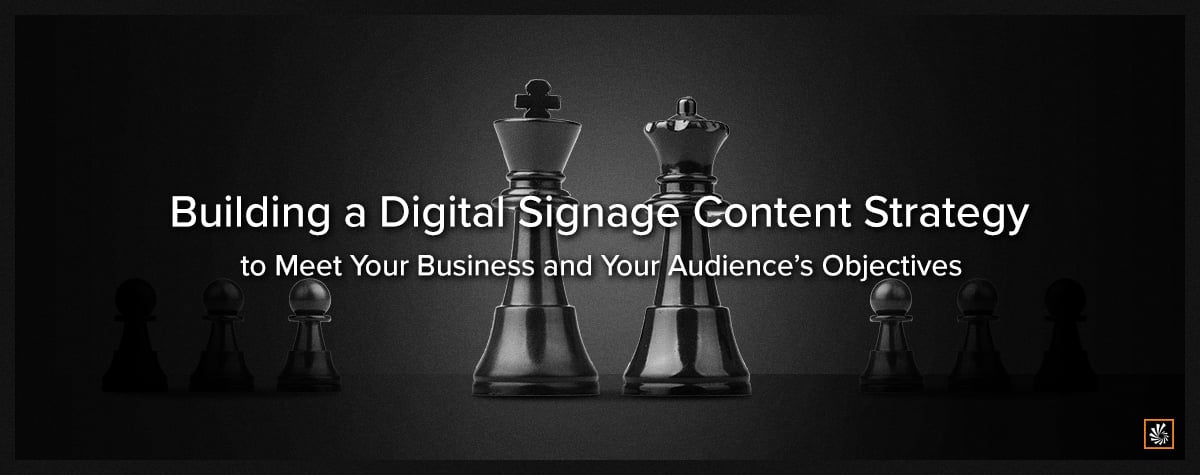Choosing Digital Signage Content Types to Suit Your Needs
We started this series talking about why it is content, not just software and hardware, that is so critical to the success of your digital signage network. We then examined the many ways digital signage is a truly unique medium when compared with other communication vehicles, and then why building a digital signage content strategy should come before creating content (or even buying digital screens). Now that you know what you want your signage to accomplish for each location in the enterprise, it’s time to choose the types of digital signage content you should build.
First, let’s dispel a few misconceptions about digital signage content
Before determining which types of content to build, there are some common yet completely understandable misconceptions to be aware of. Let’s get those out of the way first.
- “The content I already have will work just fine.”
It’s natural to want to reuse existing content assets when possible—and some of that content may work. However, digital signage is a unique medium, and its placement and audiences are unique, too. Video storytelling that relies on audio, for example, may not be appropriate for screens in every location.
- “People will hang around to watch my content."
The fact is that customers and employees are busy people, and while they may pause for 30 seconds in front of a screen, they won’t stay in front of those screens forever. Your content has to convey its message quickly and concisely. (That said, longer forms of content might be great for venues like restaurants, amusement parks, or others with long dwell or wait times.)
- “I’ve bought touchscreens, so all my content should be interactive."
No matter how tempting it is, not every venue and every screen is appropriate for an interactive experience. As we’ll discuss, it depends on the purpose and placement of the screen.
We aren’t saying all digital signage content has to be short, boring, or static—far from it. Just consider that in out-of-home, outdoor, or retail environments, digital signage is often a “glance medium.” The opportunity to get your message across may only be a few seconds. If you intend to use existing assets or those from broadcast or online sources or social media, you may need to rework them and apply best practices to suit the audience, purpose, and placement of each screen.
The three core types of digital signage content
As we’ve already stressed, the type of content you create for your network is (or should be) highly dependent on the purpose of the individual screens, the intended audience (and its purpose), and the desired effect on that audience—in other words, on your digital signage content strategy. There are three basics types of content and how and where they each can be effective.
- Traditional video media
Most people are familiar with traditional video content—camera shots, action, talking heads, and so on. You can use this type of digital signage content in certain environments, but, again, it has to be the right location for this to be effective. A very effective alternative to traditional video content is motion graphics, which can often convey a message more quickly and simply. This type of video content is common online, but lately it is also showing up more on TV and traditional broadcast mediums. That’s because these are turning into more of a glance media marketplace where people can ignore or skip through ads. Motion graphics rely on animated typography and iconography and allow businesses to still communicate with buyers, even as they fast forward through commercials. Because motion graphics aren’t video, they may capture the attention of your audience—buyers have learned to ignore videos that have the look and feel of commercials.
- Dynamic, data-driven content
Dynamic content, on the other hand, is created and displayed “on the fly” based on appropriate data. For example, you might have a 10-second spot that dynamically pulls images from an Instagram feed or text from a Twitter feed. You might also use data, images, and current pricing from your inventory system to construct an in-the-moment promotion. Or maybe you tap the local weather forecast data to promote coats or umbrellas. The possibilities are endless.
Dynamic content can include brand elements, logos, motion graphics, messages that fly across the screen, and more—all built by an HTML application and based on data in the here-and-now rather than being produced in advance. Not only can this approach be valuable for shoppers and guests, it can be essential for employee-facing signage where you might consider visualizations of content like performance metrics or customer reviews. Regardless of the whether the data is from internal or third-party sources, the system can use the data and assets to build a piece of relevant media content in real time.
- Interactive content
As we mentioned earlier, interactive content doesn’t belong on every digital sign in every location. Where it is appropriate, however, it can be highly engaging and effective. Obviously, interactive content requires user input, usually a touchscreen or other device. Early interactive content included “kiosk” type applications, such as retail product advisors or wayfinding systems like you’d find in a mall or airport.
But lately interactive applications have become more pervasive, in part because they have moved beyond the traditional touchscreen and trackball input devices. Retailers and employers are creating voice-activated and controlled content that lets users talk to the digital signage screen. Motion-activated content is also growing in popularity, for example, where the displayed content changes depending on whether people are present in front of the digital sign. One of the latest trends is to enable interactions between personal mobile devices and digital signage displays, allowing you to produce even more personal, relevant content experiences.
Your infrastructure determines the kinds of content you can create and show
Of course, the infrastructure of your digital signage network does play a part in the types of content you create. In the past, digital signage devices weren’t physically networked—meaning the content had to be taken and updated manually screen by screen. So, having your devices on an actual network is the number one infrastructure requirement if you want to deliver and update content with any regularity.
Today, the types of content you can show are more determined by things like screen size and resolution and—for the more interactive types of content—by the presence of I/O components like microphones, cameras, motions sensors, and so on. In addition, the software you use to manage, distribute, and play the content can expand or restrict your options. For example, unlike Reflect Spark Framework, not all digital signage software will allow you to easily create and play HTML applications as content.
But the main considerations when selecting what types of digital signage content are…
With all the digital signage content and device types to choose from, once again we come back to the importance of knowing your business goals for digital signage—and your audiences’ goals, too. Have you considered your audiences’ wants and needs, the environment in which you will engage them with digital experiences, and the specific purpose of each and every device? The most successful digital signage deployments have content programs that hit the “sweet spot” where the objectives of the brand/marketer intersect with those of the audience. In short, your digital signage content strategy should dictate the type of content you produce.
Next time, we’ll focus on “feeding the content beast” for the long term, including some best practices for tuning and optimizing your content and how to measure its effectiveness. In the meantime, we invite you to connect with us on LinkedIn and Twitter. Better yet, contact us to find out how Reflect Systems and its products and solutions—including our ReflectView digital signage content management platform—can help ensure you get the best possible ROI from your digital signage network and your content.
Share this
You May Also Like
These Related Stories

What Is a Digital Signage Content Management System?

Building a Digital Signage Content Strategy to Meet Your Business’ and Your Audience’s Objectives


